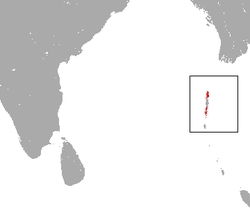안다만관박쥐
|
| |
|---|---|
| 생물 분류ℹ️ | |
| 계: | 동물계 |
| 문: | 척삭동물문 |
| 강: | 포유강 |
| 목: | 박쥐목 |
| 과: | 관박쥐과 |
| 속: | 관박쥐속 |
| 종: | 안다만관박쥐 (R. cognatus) |
| 학명 | |
| Rhinolophus cognatus | |
| K. Andersen, 1906 | |
학명이명 | |
|
Rhinolophus famulus | |
| 안다만관박쥐의 분포 | |
 안다만관박쥐의 분포 지역 | |
| 보전상태 | |
|
| |
안다만관박쥐(Rhinolophus cognatus)는 관박쥐과에 속하는 박쥐의 일종이다.[2] 인도 안다만 제도의 토착종이다. 자연 서식지는 아열대 또는 열대 기후 지역의 습윤 저지대 숲과 망그로브 숲, 습지이다.
분류학[편집]
안다만관박쥐는 이탈리아 동물학자 지글리올리(Enrico Hillyer Giglioli)가 1892년 5월에 처음 수집했다. 표본은 안다만제도 포트블레어에서 수집되어, 제노바자연사박물관(Museo Civico di Storia Naturale di Genova)에서 보관하고 있으며, 덴마크 동물학자 안데르센(Knud Andersen)가 1906년 처음 기술했다.[3]
관박쥐류는 아주 특이하기 때문에 몇 개의 근연종군으로 좀 더 나눌 수 있고, 안다만관박쥐는 꼬마관박쥐군("pusillus" species group)으로 분류된다.[4]
꼬마관박쥐군에 속하는 나머지 박쥐들은 다음과 같다.
- 뾰족관박쥐 (R. acuminatus)[5]
- 볼록관박쥐 (R. convexus)[6]
- 작은일본관박쥐 (R. cornutus)[7]
- 이마이즈미관박쥐 (R. imaizumii)[8]
- 블라이스관박쥐 (R. lepidus)[4]
- 포르모사작은관박쥐 (R. monoceros)[8]
- 오스굿관박쥐 (R. osgoodi)[8]
- 꼬마관박쥐 (R. pusillus)[8]
- 쇼트리지관박쥐 (R. shortridgei)[4]
- 작은네팔관박쥐 (R. subbadius)[4]
특징[편집]
긴 주걱형 첨두를 갖고 있다. 첨두 측면 가장자리는 오목하다.[6] 전완장은 39~39/7mm이고, 두개골 길이는 17.2~18.6mm 정도이다.[6] 50마리 이하로 무리를 지어 매달려 생활한다.[1]
생태[편집]
다른 종과 함께 군집 생활을 하는 것으로 알려져 있다. 함께 매달려 생활하는 종으로 돕슨관박쥐와 포모나둥근잎박쥐이 포함될 수 있다.[9] 1월에 동면 상태의 개체군을 관찰할 수 있다. 세대 기간은 평균 7.5년이다.[1]
분포 및 서식지[편집]
안다만 제도에서만 서식하고 인근 니코바르 제도에서는 발견되지 않는다. 서식지 상한 고도는 600m이다. 낮 동안에는 동굴 안에 매달려 지내고, 나무 구멍 속에서 발견되기도 한다.[1]
각주[편집]
- ↑ 가 나 다 라 Aul, B & Chakravarty, R (2016). “Rhinolophus cognatus”. 《The IUCN Red List of Threatened Species》 (IUCN) 2016: e.T19533A21981807. doi:10.2305/IUCN.UK.2016-2.RLTS.T19533A21981807.en.
- ↑ Simmons, N.B. (2005). “SPECIES Rhinolophus cognatus”. Wilson, D.E.; Reeder, D.M. Mammal Species of the World: A Taxonomic and Geographic Reference (영어) 3판. 존스 홉킨스 대학교 출판사. 312–529쪽. ISBN 978-0-8018-8221-0. OCLC 62265494.
- ↑ Andersen, K. (1906). On some new or little-known bats of the genus Rhinolophus in the collection of the Museo Civico, Genoa. Annali del Museo Civico di Storia Naturalia di Genova, Serie, 3(2), 1905.
- ↑ 가 나 다 라 Srinivasulu, C., & Srinivasulu, B. (2012). South Asian Mammals. In South Asian Mammals (pp. 9-98). Springer New York.
- ↑ Bates, P. J.; Thi, M. M.; Nwe, T.; Bu, S. S. H.; Mie, K. M.; Nyo, N.; Khaing, A. A.; Aye, N. N.; Oo, T. & Mackie, I. (2004). “A review of Rhinolophus (Chiroptera: Rhinolophidae) from Myanmar, including three species new to the country”. 《Acta Chiropterologica》 6 (1): 23–48. doi:10.3161/001.006.0103.
- ↑ 가 나 다 Csorba, G. (1997). “Description of a new species of Rhinolophus (Chiroptera: Rhinolophidae) from Malaysia”. 《Journal of Mammalogy》 78 (2): 342–347. doi:10.2307/1382887. JSTOR 1382887.
- ↑ Wu, Yi; Motokawa, Masaharu; Harada, Masashi; Thong, Vu Dinh; Lin, Liang-Kong & Li, Yu-Chun (2012). “Morphometric variation in the pusillus group of the genus Rhinolophus (Mammalia: Chiroptera: Rhinolophidae) in east Asia”. 《Zoological Science》 29 (6): 396–402. doi:10.2108/zsj.29.396. PMID 22639811.
- ↑ 가 나 다 라 Simmons, N.B. 2005. Order Chiroptera. Pp. 312–529 in Wilson, D.E. and Reeder, D.M. (eds.). Mammal Species of the World: a taxonomic and geographic reference. 3rd ed. Baltimore: The Johns Hopkins University Press, 2 vols., 2142 pp. ISBN 978-0-8018-8221-0. Simmons, N.B. 2005. Order Chiroptera. Pp. 312–529 in Wilson, D.E. and Reeder, D.M. (eds.). Mammal Species of the World: a taxonomic and geographic reference. 3rd ed. Baltimore: The Johns Hopkins University Press, 2 vols., 2142 pp. ISBN 978-0-8018-8221-0
- ↑ Aul, B. 2003. The Status and Distribution of Bats in Andaman and Little Andaman Islands. Madras Crocodile Bank Trust, Mamallapuram, India.

